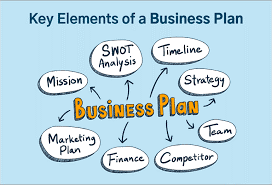Every major company we know today, whether it’s Amazon, Airbnb, or Spotify, started with a simple idea but was backed by a strong business plan. Then what is the difference between a dreamer and a successful entrepreneur? The answer lies in their approach and structure. A business plan will provide direction, ensure clarity, and win the confidence of the investors. But each plan is not the same. To make it effective, you need to include some elements. In this blog, we will uncover the seven crucial sections that every startup business plan should have to stand out in today’s business landscape.
Bring Life to Your Visions and Turn Them into a Structure

Before we take a look at the details of the critical sections to add to the plan, it is essential to understand why structure is important.
Take the startup like a building that is under construction, without a foundation, walls, and support beams, it collapses. Similarly, a business plan is divided into key sections that hold the entire strategy together. Each section addresses investors, partners, and you, the founder. So, let’s explore these seven critical sections that must be part of the startup business plan you will design.
- Executive Summary: A Big Picture But In A Few Words
The executive summary is the first and most crucial section of a business plan. But the remarkable fact is that it is written at the end of the plan. This section captures the soul of your business idea concisely, making it the hook for the investors. You can take it as your elevator pitch written on paper. A strong one will convince the readers to dig in deep. When you write this section, your focus must be on these things.
- Provide a short overview in the form of an introduction paragraph. It will tell its readers what your company does and why it matters.
- Add a mission statement. This is a clear description of your purpose and the long-term vision.
- Talk about the things that set your business apart from the competitors.
- Don’t forget to glance at profitability goals or projected figures.
- Quote the amount you will need for startup, and the way you have planned to use the invested amount. Providing a clear breakdown of the investment is essential for the new investors.
- The Company Description: Painting Your Identity

One of the critical sections of every startup business plan. In this section, you will provide the depth of your business identity. It provides answers to the questions of ‘Who’, ‘What’, and ‘Why’.
Investors are interested in knowing who is behind your ideas and what drives them. By providing a transparent background and outlining the problems you aim to solve, your plan will establish credibility and trust.
- Narrate your foundation story, the inspiring ideas behind your startup, and the way it came into being.
- Disclose the business structure. Tell your readers whether it is a sole proprietorship, a partnership, or a limited company.
- You even need to tell if your startup fits within the larger industry landscape.
- Mention the vision, mission, and principles that are the guiding powers for your operation.
- And don’t forget to tell the problems your business will resolve for its targeted audience. It can be your launch product that people have been waiting for so long.
- Market Analysis: Knowing The Battlefield
You cannot design a plan without a clear understanding of the market. Setting up a business and writing Ireland business plans, this section will cover how well you have researched your industry and the audience. It demonstrates the awareness of competitors, customer demands, and the trends that can affect your business.
- Describe your ideal customers in detail, including their age, habits, and preferences.
- The potential size of your targeted market. The division must be based on revenue and customer base.
- A review and stats of your competitors. They are the key players of your industry, and knowing their strengths and weaknesses is essential.
- Identify existing gaps and determine how you will fill them when competitors fall short.
- Some of the predictions of the future trends in the market, and the ways you will be part of them.

- Organization And Management: The People Who Run The Setup
Do you know, your brilliant idea can fall flat without the right team?
In this section, you will highlight the human resources behind the venture and their expertise. It reassures stakeholders that the individuals working with you are capable leaders who are well-informed about the current market situations.
- Talk about the background of the founder. You need to state the skills and the experience in the field. Even mention all these details of each individual if there is more than one founder.
- The details of the management roles of each employee working under your name.
- All the advisors and mentors will use their expertise to guide the business in the right direction.
- Quote the figures of ownership distribution. Mention the share percentage of the partners and the investors.
- Promise that you have a strategic plan in place to hire a stronger workforce in the future.
- Products And Services: Things You Offer

Apart from other sections, one of the key components of every startup business plan is a description of the products and services. Here, you will describe the things you are selling. It is a product or a service that investors need clarity about its value, uniqueness, and potential. In this section, you will explain why people should choose you over other competitors.
- State the details of your products, including their features and specifications.
- If you are a service-based company, discuss the methods you will use to deliver your product and its ongoing maintenance.
- Some of the reasons why customers would buy your product or service.
- The lifecycle of your offering. Mention the relevance of your product before the user needs to upgrade it.
- Highlight the patterns, trademarks, and copyrights that protect your idea.
- The Marketing And Sales Strategies: Spreading The Word
Your launched product is the best one that can fulfil the needs of the targeted customers. But without a marketing plan, it is like a book that nobody knows exists. When writing an investor business plan, it is essential to explain how you will attract and retain your customers. You need to combine creativity with measurable strategies.
- Talk about how you want your brand to be perceived.
- Narrate the logic behind the price points.
- Highlight all the promotional tactics, including advertising, digital campaigns, and influencer partnerships.
- State your journey from customer awareness to conversion.
- Work on customer retention, such as loyalty programs, after-sales support, and community building.
| Strategy | Percentage of Budget |
| Social Media Ads | 35% |
| Influencer Marketing | 20% |
| Traditional Media | 15% |
| Events & Sponsorship | 10% |
| Customer Retention | 20% |
- Financial Projection: Turning Vision Into Numbers
The numbers will provide you with confidence. In this area, give a clear financial roadmap that shows how your business will generate income, cover expenses, and grow over time.
- State the initial cost you will need for the launch operations.
- Talk about the expected sales figure for the coming 3-5 years.
- Mention the inflow and the outflow of the money.
- Don’t forget to quote the projected profitability over time.
The Final Comment
Every startup business plan is more than a document. It is a roadmap that transforms imagination into achievable milestones. Each section plays a crucial role, from capturing attention with an executive summary to providing reassurance to investors with financial projections.
Without a structured plan, even the brightest ideas can stumble in the face of uncertainty. By covering these seven vital sections, entrepreneurs not only strengthen their business strategy but also gain clarity and confidence. Ultimately, a business plan is not just for investors. It serves as the guiding star that keeps your venture moving toward long-term success.












Leave a Reply